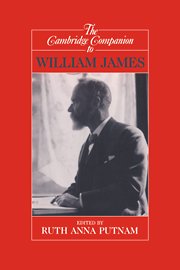Book contents
- Frontmatter
- Introduction
- 1 Pragmatism and introspective psychology
- 2 Consciousness as a pragmatist views it
- 3 John Dewey's naturalization of William James
- 4 James, Clifford, and the scientific conscience
- 5 Religious faith, intellectual responsibility, and romance
- 6 The breathtaking intimacy of the material world
- 7 James, aboutness, and his British critics
- 8 Logical principles and philosophical attitudes
- 9 James's theory of truth
- 10 The James/Royce dispute and the development of Jarnests "solution"
- 11 William James on religious experience
- 12 Interpreting the universe after a social analogy
- 13 Moral philosophy and the development of morality
- 14 Some of life's ideals
- 15 “A shelter of the mind”
- 16 The influence of William James on American culture
- 17 Pragmatism, politics, and the corridor
- 18 James and the Kantian tradition
- Bibliography
- Index
15 - “A shelter of the mind”
Henry, William, and the domestic scene
Published online by Cambridge University Press: 28 May 2006
- Frontmatter
- Introduction
- 1 Pragmatism and introspective psychology
- 2 Consciousness as a pragmatist views it
- 3 John Dewey's naturalization of William James
- 4 James, Clifford, and the scientific conscience
- 5 Religious faith, intellectual responsibility, and romance
- 6 The breathtaking intimacy of the material world
- 7 James, aboutness, and his British critics
- 8 Logical principles and philosophical attitudes
- 9 James's theory of truth
- 10 The James/Royce dispute and the development of Jarnests "solution"
- 11 William James on religious experience
- 12 Interpreting the universe after a social analogy
- 13 Moral philosophy and the development of morality
- 14 Some of life's ideals
- 15 “A shelter of the mind”
- 16 The influence of William James on American culture
- 17 Pragmatism, politics, and the corridor
- 18 James and the Kantian tradition
- Bibliography
- Index
Summary
Men always have attempted and always will attempt to make their minds dwell in a more reasonable world, just as they always have sought and always will seek to make their cities and their homes more beautiful. (MEN, 3)
If his hand comes in contact with an orange on the table, the golden yellow of the fruit, its savor and perfume will forthwith shoot through his mind. . . . The voice of the violin faintly echoes through the minds as the hand is laid upon it in the dark. (PP* 1:556)
When Henry James writes of “the house of fiction” in his preface to the New York edition of The Portrait of a Lady, he teaches us to range analogically among domestic sites. He asks us to consider the relations, between, on one hand, the temporary home where he sits writing the novel - “I had rooms on Riva Schiavoni, at the top of a house near the passage leading off to San Zaccaria; the waterside life, the wondrous lagoon spread before me, and the ceaseless human chatter of Venice came in at my windows” - and, on the other hand, the conceit of the artist's process of building, his “edification.” Describing “the house of fiction,” he writes, “The spreading field, the human scene, is the 'choice of subject'; the pierced aperture, either broad or balconied or slit-like and low-browed, is the 'literary form'; but they are, singly or together, as nothing without the posted presence of the watcher - without, in other words, the consciousness of the artist” (James 1984, 1070, 1075).
- Type
- Chapter
- Information
- The Cambridge Companion to William James , pp. 300 - 321Publisher: Cambridge University PressPrint publication year: 1997



